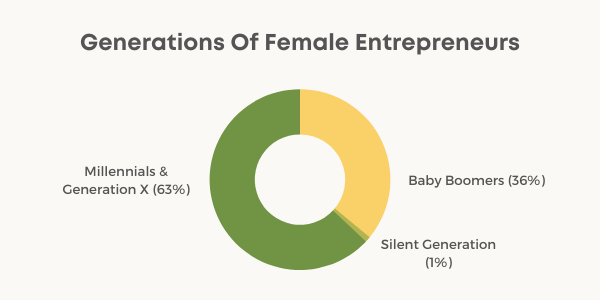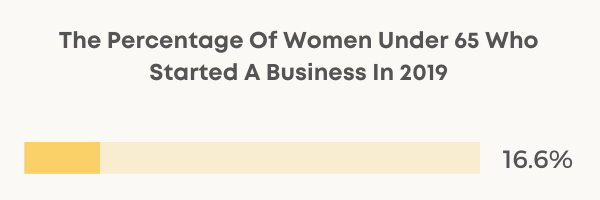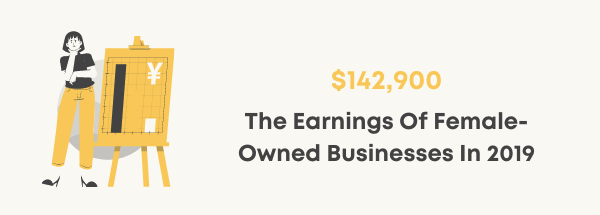Female entrepreneurship statistics can help us determine how many women-owned businesses there are.
Also, we can see how many women from different age groups are entrepreneurs.
Women are a driving force in the economy, showing off their skills and expertise in leadership and business.
Let’s see how women are doing as entrepreneurs!
Key Women Entrepreneurs Statistics (Editor’s Pick)
- There are 252 million female entrepreneurs worldwide.
- In 2019, there were 13 million female-owned businesses in the US.
- 63% of US female entrepreneurs are Millennial or Generation X.
- Female entrepreneurs earn 28% less than male ones.
- 31% of European women are business owners.
25 Statistics About Female Entrepreneurs
1. There are 252 million female entrepreneurs in the world.
According to data for 2019/2020 reported in the Global Entrepreneurship Monitor, there are 252 million female entrepreneurs in the world. Moreover, the same report says that there has been a rise in female entrepreneurial activity in the last years and that it rose to an average of 10.2%.
Source: Babson
2. For every 10 male entrepreneurs, there are seven female ones.
There are more male than female entrepreneurs around the globe, reports Babson. Moreover, for every seven female entrepreneurs, there are 10 male ones. Yet, in some countries, there is the same number of female and male entrepreneurs. These include Thailand, Panama, Qatar, Angola, Madagascar, and Indonesia.
Source: Babson
3. Female entrepreneurs hire around eight people.
Women entrepreneurs hire around eight people on average, according to the Office for Advocacy. In comparison, male entrepreneurs hire around 12 employees on average.
Source: Office of Advocacy
4. There were 13 million women-owned businesses in the US in 2019.
According to data released from American Express, in 2019, there were 13 million female-owned businesses in the United States. Despite the fact there are more male than female businesses there, the latter is on the rise.
Source: American Express
5. More than seven in 10 (71%) of women start a business to make a difference in the world.
Women start businesses for many reasons. When asked about it, 71% of them said they start a business to make a difference in the world. Also, 65% do it to earn a high income or build wealth. Furthermore, 45% report they start a business because jobs are scarce. Finally, 29% of women entrepreneurs start a business to continue a family tradition.
Source: Babson


6. Women entrepreneurs increased the number of their employees by 8% between 2014 and 2019.
According to female entrepreneurship statistics for 2019, there has been an increase in the number of employers of 8% between 2014 and 2019. This is according to data for that time by American Express. At the same time, the increase in employees for all businesses was only 1.8%.
Source: American Express
7. The number of US female-owned businesses rose by 21% between 2014 and 2019.
In the United States, in the period between 2014 and 2019, there has been a significant rise in women-owned businesses. The number rose by 21% in these five years, according to American Express. On the other hand, the number of all businesses grew by only 9%.
Source: American Express
8. 63% of female entrepreneurs are Millennials or Generation X.
According to Guidant Financial, 63% of female entrepreneurs belong to either Millennials or Generation X. Moreover, only 1% of them belong to the Silent Generation. On the other hand, 36% of them are Baby Boomers.
Source: Guidant Financial


9. The most popular industry that is female-owned and female-led is retail (16%).
Retail (16%) is the most popular female-owned and led industry. In the second place, health, beauty, and fitness services (13%) are also popular. Furthermore, so are business services (11%), food and restaurant (10%), and residential and commercial services (7%), according to Guidant Financial.
Source: Guidant Financial
10. 27% of the US small business owners are women.
According to Guidant Financial data on small businesses in the United States, only 27% of them have female owners. Moreover, this means that the large majority of small businesses in the US are still owned by men.
Source: Guidant Financial
11. In the US, 16.6% of women under 65 started a new business.
In 2019, 16.6% of women under 65 started a new business in the United States. Furthermore, according to the Global Entrepreneurship Monitor for 2019, so did 18.3% of men in the same age group.
Source: Babson


12. In 2109, American women started 1,817 new businesses per day.
According to American Express, women started 1,817 new businesses per day in 2019 on average. As it turns out, 2019 was a successful year for women starting a new business.
Source: American Express
13. Female entrepreneurs earn 28% less than male entrepreneurs in the US.
According to data from FreshBooks, male entrepreneurs earn more than female ones in the US. The exact figure says that women earn 28% less. This is no surprise as that is mostly the case with earnings in most industries.
Source: FreshBooks
14. To start their business, 38% of female business owners used cash.
While there are different ways to start a business, 38% of female business owners used cash, rather than some other method. These other methods include loans, investments, savings, etc.
Source: Guidant Financial
15. In 2019, on average, female-owned businesses earned $142,9000.
Figures from American Express for 2019 show that businesses with female owners earned $142,900 on average. Moreover, the average earnings across all private businesses in the same year were $474,900.
Source: American Express


16. In 2021, 31% of current and aspiring entrepreneurs are women.
While 31% of current and aspiring entrepreneurs who participated in a Guidant Financial 2021 study are women, 66% are men. For comparison, in 2020, there were 27% of current and aspiring female entrepreneurs.
Source: Guidant Financial
17. Women get one dollar back for every 80 cents invested.
Women get one dollar back for every 80-cent investment, according to Babson. Moreover, the same source concludes that this is what brings the GDP up while bringing the mortality rates down.
Source: Babson
18. The number one reason for the success of female entrepreneurs is communication skills (37%).
The number one reason for the success of women entrepreneurs is their people and communication skills (37%). After that, another reason for their success is self-discipline (34%). Finally, the third reason for their success is their money management skills.
Source: National Business Capital and Services
19. 14% of businesses with female owners employ between 11 and 50+ workers.
While female-owned businesses hire eight people on average, 14% of them actually employ between 11 and 50+ workers. Also, in 20% of cases, the owner is the only employee. Furthermore, 19% employ between six and 10 workers. Finally, 46% have two to five workers.
Source: Guidant Financial
20. Annually, women-owned businesses make $1.8 trillion in the US.
According to data from American Express, female entrepreneurs and their businesses make $1.8 trillion per year in the United States. Moreover, 13% of 309 companies that made more than $1 billion in 2021 have female founders or female co-founders, according to Crunchbase.
Source: American Express
21. Just over three in 10 European women are entrepreneurs.
While 51% of the European population are women, they are a minority in the world of enterprise. In fact, only 31% of them are entrepreneurs, on average. Also, 39% are self-employed and 30% are startup entrepreneurs.
Source: MDPI


22. South Asia has less than 20% of women entrepreneurs.
While the figures in Europe are not great, they are even smaller in South Asia. Less than 20% of women in South Asia are entrepreneurs. On the other hand, almost half of all entrepreneurs in East Asia and the Pacific are women.
Source: MDPI
23. More than six in 10 (64%) of new female-owned businesses were started by women of color.
According to data from American Express for 2019, 64% of all new businesses started by women were women of color. This is very promising and encouraging data for the future.
Source: American Express
24. In 2019, women entrepreneurs employed 9.4 million workers.
According to the annual report for 2019 from the National Women’s Business Council, women-owned businesses employ around 9.4 million workers. For comparison, there are around 13 million businesses with female owners in the US.
Source: National Women’s Business Council
25. There has been an increase of 114% in female-owned businesses in the last 20 years.
Between 1999 and 2019, there has been an increase of 114% in businesses with female owners. This finding shows that entrepreneurship is finally becoming more open to women in the United States.
Source: Business Insider
Final Verdict
In conclusion, women entrepreneurs statistics show that, while female entrepreneurs are on the rise, there is still a long way to go before the situation is more equal between men and women in entrepreneurship. Also, entrepreneurs statistics and figures show a deeper insight into the world of entrepreneurship globally. To find out more about how black women are dealing with entrepreneurship, check out our article with black female entrepreneurs statistics.































Find Us on Socials